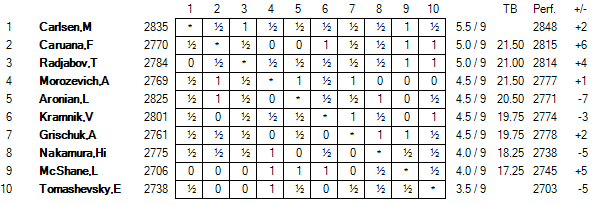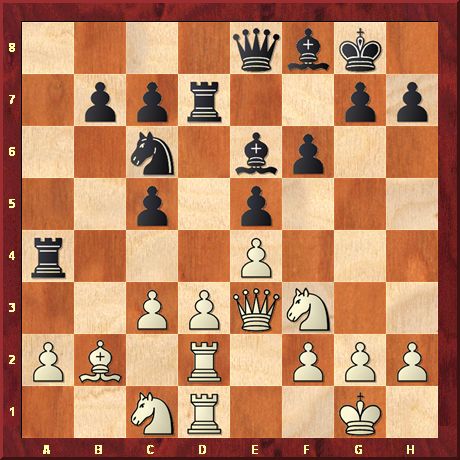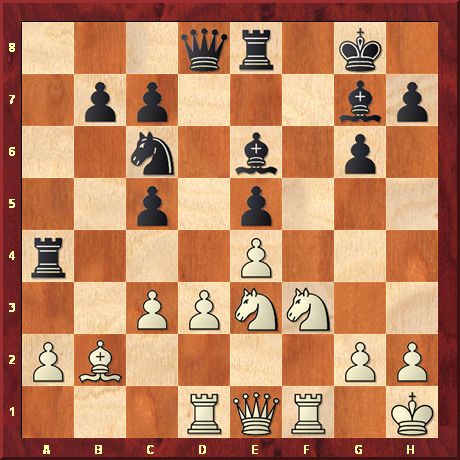Top-rated Magnus Carlsen won the 7th Tal Memorial in Moscow, one of the strongest chess tournaments of the year. The Norwegian grandmaster was the only undefeated player in a field of 10 world-class players.
He didn't play for more than four months and it took him a few games to shake off the cobwebs. Not only did he start slowly, but he was in danger of losing a couple of times. "I was suffering," he admitted. In round four against Russia's Alexander Grischuk, Carlsen played like the magician Mikhail Tal, leaving his bishop under attack for eight moves. " It was the energizer," he said and although he only drew that game, he was in the driver's seat in the remaining games.

"The victory is nice," Carlsen said. "There were twists and turns nobody could foresee." Whoever was in the lead was pulled back by the crowd. Only Russia's Alexander Morozevich looked invincible. He was running away with the tournament, piling up three wins and draws. He could not do anything wrong or so it seemed. But when everything looked wonderful he did what he sometimes does: he self-destructed, losing three games in a row.
Others jumped at the opportunity and with two rounds to go five players shared first place. It was a brutal final stretch for Vladimir Kramnik. Unbeatable for most of his career, the former world champion suddenly lost two games and took himself out of contention. The youngest player, the Italian GM Fabiano Caruana, 19, was in the lead going into the last round, but he lost, too.
It was up to Carlsen to grab first place and he did it in an impressive way. He didn't strike like Misha Tal, but like another legend, the late Estonian grandmaster Paul Keres. More than 50 years ago, Keres created a perfect model against white's passive play in the twice-delayed Exchange variation of the Spanish. Did Magnus know the game?
McShane,Luke (2706) - Carlsen,Magnus (2835)
7th Mikhail Tal Memorial, Moscow 18.06.2012
1.e4 e5 2.Nf3 Nc6 3.Bb5 a6 4.Ba4 Nf6 5.0-0 Be7 6.Bxc6 dxc6 7.d3
("Play proceeds slowly," said Carlsen. "It is more or less equal." Against Max Blau in Zurich in 1959, the legendary Estonian grandmaster Paul Keres provided a blueprint for how to play this variation with the black pieces: 7.Qe1 Be6 8.d3 Nd7 9.b3 c5! 10.Bb2 f6 11.Nbd2 0-0 12.Qe3 Nb8 [Bringing the knight to c6 where it controls the square d4.] 13.Rfd1 Nc6 14.c3 Qe8 15.Rac1 [After15.d4 cxd4 16.cxd4 Nxd4 17.Nxd4 Bc5 black is better] 15...Rd8 16.Nf1 Rf7 17.Ng3 Bf8 18.Rd2 Rfd7 19.Rcd1 a5! 20.Ne2 a4 21.bxa4? Ra8 22.Nc1 Rxa4

White is besieged and Keres went on to win in 59 moves. It is incredible how similar Carlsen's
game turns to be more than a half century later.)
7...Nd7 8.b3 0-0 9.Bb2 f6 10.Nc3 Re8 11.Kh1 Nf8 12.Ne2 c5!
(Containing the central d-pawn.)
13.Nh4 Ne6 14.Nf5 Bf8 15.Ne3 Nd4
(Jumping into white's territory, Carlsen claims a slight space advantage.)
16.f4
(McShane is not going to wait like Blau and seeks some play on the kingside.)
16...Be6 17.fxe5 fxe5 18.Ng1 g6 19.c3
(Pushing the annoying knight back creates weaknesses. After 19.Nf3 Carlsen considered 19...Bh6 20.Nc4 Bg4 and black is slowly gaining speed.)
19...Nc6
(Carlsen's knight finally made it to the square c6.)
20.Nf3 Bg7 21.Qe1 a5!
("I forgot about a5," said McShane. Like in Keres's game, the rook pawn will shatter white's queenside. McShane was hoping for 21...Qxd3? 22.Rd1 Qb5 [22...Qxe4 23.Ng5 wins.] 23.Nd5 with white's advantage. )
22.Rd1 a4 23.bxa4 Rxa4
(The correct decision, although Carlsen briefly considered 23...Bxa2.)

24.a3
(White is positionally lost. Black only needs to consolidate.)
24...Rf8 25.Bc1 Ra8
("Reconnecting the rooks," Carlsen explained.)
26.Qg3 Bb3 27.Rde1
(Too optimistic, but after 27.Rd2 Bh6 28.Qe1 b6 29.Rb2 Be6 30.Qe2 Qd7 black is gradually improving his position. White has no counterplay.)
27...Qxd3 28.Ng4 Be6 29.Nh6+ Kh8 30.Qh4 Bf6 31.Bg5 Bxg5 32.Qxg5 Kg7 33.Qc1
(White has problems with the knight on h6, but after 33.Ng4 Bxg4 34.Qxg4 Rad8! black is ready to pick up a few loose pawns.)
33...Rf4 34.Rd1?
(Missing the last chance to fight back: 34.Ng5 Qd6 35.Rxf4 exf4 36.Rd1 Qe5 37.Nxe6+ Qxe6 38.Qxf4 Rf8 39.Qe3 Ne5 40.h3 b6 but black still has the edge. But McShane didn't have much time to think.)
34...Qc4! 35.Rfe1 Raf8 36.Ng5 Bc8 37.g3 Rf2 38.Nf5+ gxf5 39.Nh3 Re2 40.Qg5+ Kh8
White resigned.
Note that in the replay windows below you can click either on the arrows under the diagram or on the notation to follow the game.
Image by Eteri Kublashvili

